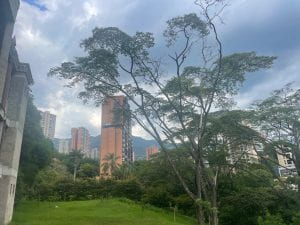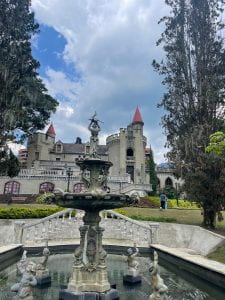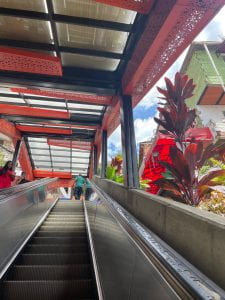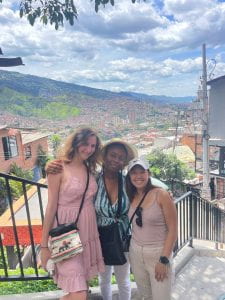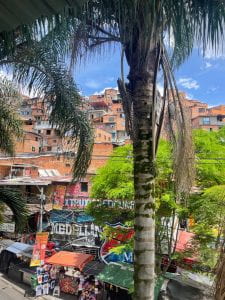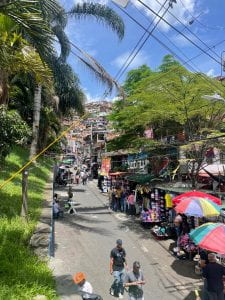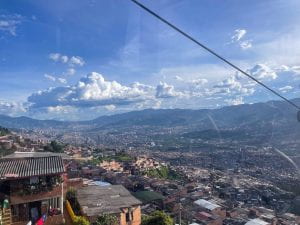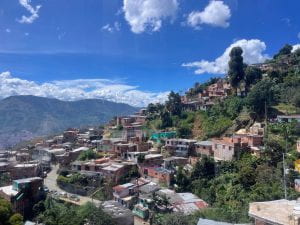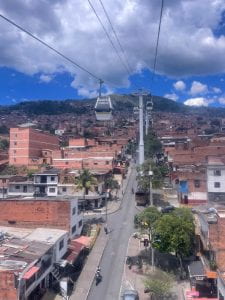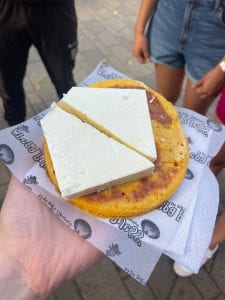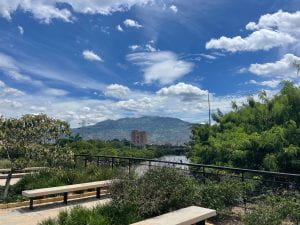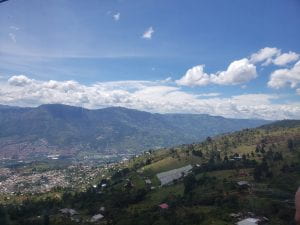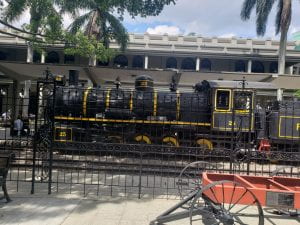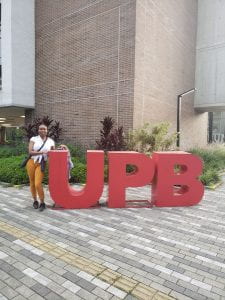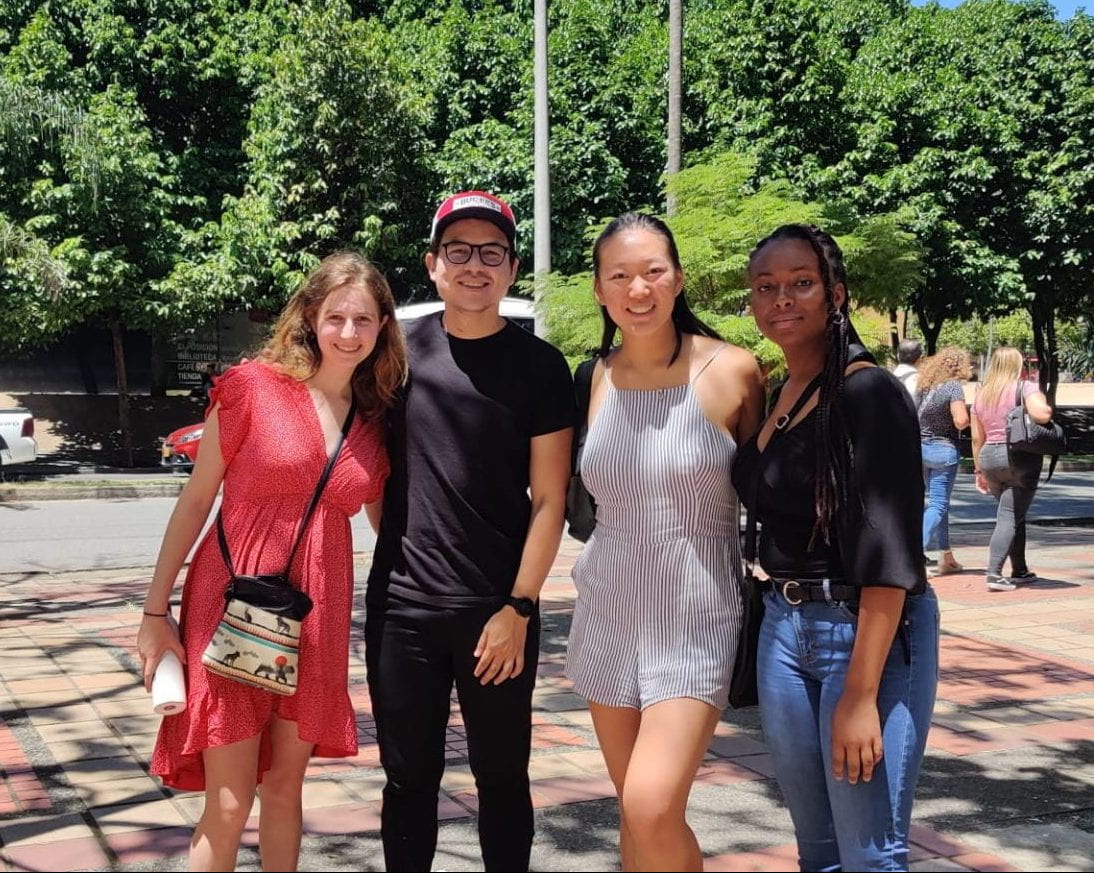In my two months in Bogotá, Colombia, I have not seen a single sunrise. The Andean Mountains stretch along the city’s eastern edge, blocking the early morning light. Still, at exactly 5:53 am, Bogotá—and its people, taxis, motorcycles, and dogs—stirs to life. (Riya and I found this out the hard way… we do not recommend living near a dog park. As cute as it sounds, spare yourself the sleep.)
Over eight weeks, I’ve been surrounded by warm locals, spectacular food, and breathtaking views. I’ve adapted to a slower rhythm than the one I knew in Dallas or Houston, a pace that lets me notice and value smaller moments. Away from Texas traffic and constant urgency, I’ve learned to find satisfaction in micro-interactions and simple pleasures to build a life centered on connection—to the people, the land, and myself.
Giving is at the heart of Bogotá.
When I landed in Bogotá after nearly 39 hours of travel, my community partner, Johan, and his spouse, Paola, picked me up close to midnight. By the next morning, I was on a TransMilenio bus to Usme, a peri-urban locality at the city’s southern edge.
As a Loewenstern Fellow, I partnered with Pontificia Universidad Javeriana’s social program PROSOFI to conduct fieldwork in Usme. My partner, Riya, and I spent hours sharing tinto and pan with older women in La Red de Huertas (“The Gardening Network”); talking with children at after-school centers; and gardening with Vigías Ambientales, high school students in their on-campus environmental program.

Part of the PROSOFI team enjoying tinto before visiting I.E.D. Nueva Esperanza!
One day, we visited Beatriz, a huertera (gardener) with peppered hair in a long braid. She spoke passionately about her garden as both sustenance and joy. After our interview, she brewed tinto and toasted bread and proudly showed us her handmade knitted purses and shampoos scented with calendula from her garden. She told us she rarely has visitors and was grateful we came to learn her story.

Here I am holding a tinto in hand. Colombia is not the place to get rid of a caffeine addiction.
This generosity was everywhere. Gardeners like Nury would hand us freshly harvested herbs, like hierbabuena, to make aromática on cold, rainy days. They gave not only food and medicinal plants, but also time, wisdom, and narrative—gifts we preserved and shared through short-form digital content so their knowledge could reach future generations.
In my life back home, I’ve often been protective of my time and attention. In Usme, I saw giving as a way of sustaining the community itself. The people I met reminded me that connection starts with something as simple as providing others with your presence and attention.
I’ve carried my lessons from Usme to Bogotá in small ways: talking for an entire flight with a stranger named Santiago about hikes and long-distance relationships; hearing the life story of an Albanian polyglot Uber driver; sharing lunch with Colombian-Americans from my hometown who invited me to visit when I return. Even across language barriers, people made time to share themselves.
Where water begins.
Our interviews also informed another project: eco-conscious workshops for Usme youth. On the way to an after-school center called El Domo, a PROSOFI team member pointed toward the nearby Sumapaz Páramo, the largest high-altitude moorland in the world. Its most iconic plant, the frailejón, absorbs rainwater and releases it slowly, guaranteeing Bogotá’s drinking water.

Frailejón
On Riya’s last day in Colombia, we hiked La Guatavita and saw the frailejón for the first time. In classrooms, we had heard students talk about it. Now, at 3,100 meters above sea level, we saw the endangered plant in person. Its survival is threatened by climate change and agricultural expansion. Climate change, for me, is no longer an abstract idea or something that happens far away—it’s the real risk that Usme youth could lose their drinking water. My daily choices—however small—are tied to their futures.
Closing reflections.
One afternoon, walking across Pontificia Universidad Javeriana’s campus, I asked Johan about his perspective on Americans. He remembered our first breakfast together, when I stood awestruck by the mountains that frame Bogotá. He said it made him notice a beauty he had stopped seeing in his daily routine.
It made me wonder: What beauty, conversations, and people do I overlook at home? My work with PROSOFI allowed me to experience a kind of sunrise–a new awakening–within myself. The environmental knowledge and relationships I’ve built here are unforgettable. Wherever I go, I hope to bring Colombia’s appreciation for life, people, and connection back with me—to my final year at Rice and beyond.
And if you’re wondering what stood out the most during my eight weeks here, it’s hard to narrow down. Colombia’s beauty revealed itself in countless ways—through people, food, landscapes, and unexpected moments. Here are a few of my favorites.
Experience my favorites for yourself.
La Cevichería
Anthony Bourdain wasn’t kidding when he included this restaurant during his visit to Cartagena, a city on the Caribbean coast. By far, they are the best muscles I have ever eaten in my whole life (condolences to my sister–your muscles will be a close second for me). Also, the Ceviche Colombiano I ordered is the most refreshing and soul-rejuvenating meal I will ever eat. Tasted like a summer break. 10000/10.

Muscles

Colombian Ceviche
Tejo
I figure this is the Colombian equivalent of bowling… maybe cornhole? To start, your gameboard is a clay pit with a ring lined with gunpowder. With your players, you pick up a heavy metal disc and trust that your friends are coordinated enough to not cause you any accidental harm. From there, scoring is based on whether your disc makes it into the ring or if there’s an explosion! Oh, and it’s often played with beer!

I lost multiple rounds of Tejo against our community partner, Johan, and his spouse, Paola.
Monserrate
Besides La Guatavita, I also hiked up Monseratte, a mountain in southern Bogotá. At 6:30 am, Riya, Paola, Johan, and Martina–Johan’s 12-year-old niece–hiked up about 550 meters of slick, rocky stairs alongside me. On this Sunday morning, next to me were older adults pilgrimaging (barefoot!) up to the church built at Monserrate’s peak. Here I was, embellished in hiking gear–a $25 pair of brown waterproof hiking boots I bought from a store in the city, a Patagonia raincoat from REI, and an Oakley outdoor backpack–and my lungs and glutes burned. Bogotá is already at 2600 meters. My body hadn’t yet adjusted to the altitude, and going up another 550 meters on foot became one of the hardest things I have ever done in my 21 years. Then again, it was the most rewarding thing I’ve ever done.

I napped for 5 hours after this very hike.
Mojarra Frita
To honor my dad, who loves ordering fried fish when we hang out on Cozumel, Mexico’s beaches, I’ve ordered my favorite traditional Colombian platter: Mojarra Frita. Unbelievable dish. I wasn’t a seafood eater until I got here, honestly. Thanks, Dad. I didn’t recognize your game.

One big ‘ole fish with a side of limonada de coco, please!
Paloquemao Fruit Market
I have to talk about Paloquemao Fruit Market to honor my mom, a fruit fanatic. This is also one of Anthony Bourdain’s stops! Many parts of this trip, from the backyard gardens to the incredible tropical fruit I’ve tried, have made me wish my mom were here to experience it. My mom would even call me on WhatsApp and ask if I could cut some leaves to take back. Sorry, Mom, let me tell you about customs.

Paloquemao Fruit Market
Finally, a huge thank you to the Loewenstern Fellowship for making all of this possible. To Kelsey Ullom, who taught me unforgettable lessons in international service and inspired me to do hard things. To Riya for being an exceptional travel buddy, medical school application advisor, fellow foodie, and personal therapist. To Johan and Paola for providing me with the best experiences, within and outside of city limits, and for forever being by my side. To the PROSOFI team, including Blanca, Erika, Marlon, and Camilo, for being patient and encouraging while we explored Usme and executed our initiatives. For Diego for giving us the creative liberty to steer our project based on our personal interests. And finally, to Santiago’s twin brother for giving us a ride back to our apartment after we met on that flight from Medellín!










































